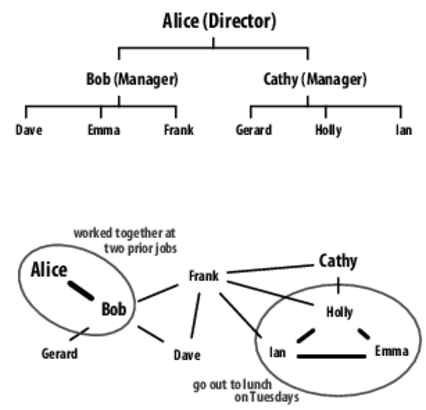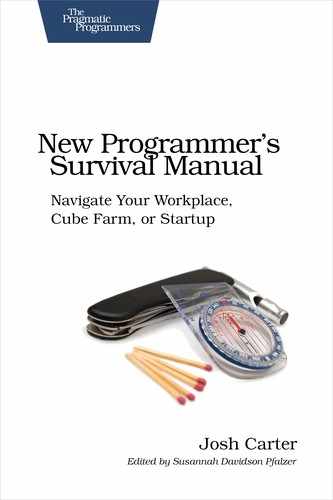| Tip 22 | Connect the Dots |
 | [Brown Belt] It takes a while to observe the connections between people. Further, you’re best served by focusing on tasks when you’re new to a job—influence will come later. |
In Chapter 5, Inside the Company we discuss the formal authority of people, that is, how they’re structured on an organizational chart. The real dynamics of influence are often different. The connections between people exert influence in ways that are hard to gauge when you’re new to the team, and you won’t find a diagram of them on the human resources website.

Figure 7. Formal and informal connections
Let’s consider the charts in Figure 7, Formal and informal connections, where the top shows the formal connections between people in a fictional engineering department and the bottom shows some informal connections. Formally, Alice is the big cheese, Bob and Cathy are frontline managers, and the rest are programmers, testers, and so on.
Over time you’ll discover the informal connections: Alice and Bob worked together at two prior jobs, so they have a strong bond of trust based on that experience. Holly, Ian, and Emma go out to lunch together every week, so they have a bond of friendship.
Dr. Karen Stephenson[39] studies these connections in a corporate environment. She goes into an organization, interviews its employees, and diagrams all these informal connections. Dr. Stephenson found that people tend to cluster, and there are key connections between clusters.
Some people are hubs that have connections to a lot of others. In our example, Frank is a hub—even though he’s just a programmer, he has a lot of pals. Being a hub makes Frank an important connection point between the two teams since he has pals on both. Perhaps Dave gets stuck on a problem that Holly solved a week ago; Frank is the person who would tell Dave, “Hey, you should chat with Holly; I think she could help.”
Another type of connection is the gatekeeper, a person who has a strong and unique connection to a key figure. Bob is a gatekeeper to Alice. Because of their long-standing professional relationship and Alice’s lack of strong ties to others, Bob has a lot of informal pull with Alice—much more than his title would imply. Let’s say Cathy is trying to start a new project within the department, but she knows it will be costly. She would be wise to convince Bob of its value because if he goes to Alice and says “Cathy has this great idea…,” that carries a lot of weight.
The final connection is what Dr. Stephenson calls a pulse-taker, one who’s on the periphery but knows a lot about what’s going on. Dave could be a pulse-taker, because he’s pals with both Bob (the gatekeeper) and Frank (the hub). Dave’s conversation with these two gives him a big-picture view of the department that neither Bob nor Frank have themselves.
If this sounds like high school all over again…well, it sort of is, because these connections are the normal social dynamics of any group. (Fortunately there’s no homecoming dance to fret over.) What this means to you is that your co-workers have influence in ways that aren’t obvious on your first day. An awareness of people’s informal connections can give you insight—and eventually influence—even though you’re low on the org chart.
Actions
Try your hand at playing Dr. Stephenson: start with the org chart as it exists formally. This may be on the company intranet, or you could ask your manager to draw it on your whiteboard.
Now ignore the org chart and start making a chart of connections. Mentally take note of day-to-day interactions like these:
-
Groups of people who go out to lunch together.
-
The folks who chat around the coffee pot in the morning.
-
That one guy from the coffee pot group who then wanders cube to cube with his coffee, chatting with anyone he catches. (Every office has that guy.)
-
The two programmers who always wind up at a whiteboard debating technical issues.
-
The person your manager goes to when he’s pissed off and needs to vent.
Based on these connections, can you identify any hubs, gatekeepers, or pulse-takers? I don’t advocate using this knowledge to subversively try to exert influence—leave that to the salespeople—but rather use it in a constructive manner. For example, if you’re stuck trying to figure out how to deploy code to a server and you don’t know where to start, ask someone you’ve identified as a hub. They may not know the answer, but it’s very likely they’ll know who does know, and they can introduce you.
